Decoding Oscar – Claude Monet
Monet was a pioneer of French Impressionism whose works can be seen in museums around the world. He was born in 1840 in Paris, France. His father worked in shipping industry, while his mother took care of the family. At an early age Monet, developed a love of drawing. He filled his schoolbooks with sketches of people, including caricatures of his teachers. His mother supported his artistic efforts, while his father wanted him to go into the shipping business. At the age of 5 Monet and his family moved to Le Havre, a port town in Normandy region.
After meeting Eugene Boudin, a local landscape artist, Monet started to explore the natural world in his world. He introduced him to painting outdoors, or plein air painting which later it has become Monet’s cornerstone in his work.
In 1859, Monet decided to move to Paris to pursue his art where he enrolled as a student at the Academie Suisse. There he met his good friend Camille Pissarro who became close friends for many years.
His wife Camille Doncieux was his muse for him, and she was in numerous paintings during her lifetime. In 1865 Monet won an acceptance to the Salon, an annual juried art show in Paris, where the show chose two of his paintings which were mainly marine landscapes. The following year he was selected again to participate in the Salon. This time, the show chose a landscape and a portrait which featured Camille, his future wife. They got married in 1870 where they went with their son to live in London.
Monet was suffering from depression and self doubt issues, he had financial problems and his father was unwilling to help them, thing that lead his to attempt suicide by trying to drown himself in the Seine River. He even got frustrated with his work. Based on reports, it said to have destroyed around 500 works of his, either by burning them, cut or even kicking them. His wife got ill during the second pregnancy where she continue to deteriorate. Monet painted a portrait of her on her death bed. After her death, Monet painted a series of paintings known as the Ice Drift.
Monet gained financial and critial success during the late 1880s and 1890s where he started a series of paintings for which he would become well known. During his time in Giverny, Monet loved to paint outdoors in the gardens, especially the water lilies he found in the pond, he painted several series of them throughout the rest of his life.
Following the death of his second wife Alice, Monet became depressed. In 1912 he developed cataracts in his right eye. During this period, he started a series of waterlily paintings commissioned by the Orangerie des Tuileries, a museum in Paris. This project was in large scale, designed to full the walls of a special space for the canvases in the museum. He wanted the works to serves as a ‘haven of peaceful meditation’.
Monet died in 1926 at his home in Giverny. This archetypal impressionist, helped change the world of painting by shaking off the conventions of the past. Monet opened the door for further abstraction in art, and he is credited with influencing such later artists as Jackson Pollack, Mark Rothko and Willem de Kooning.
“It’s on the strength of observation and reflection that one finds a way. So we must dig and delve unceasingly.”
― Claude Monet
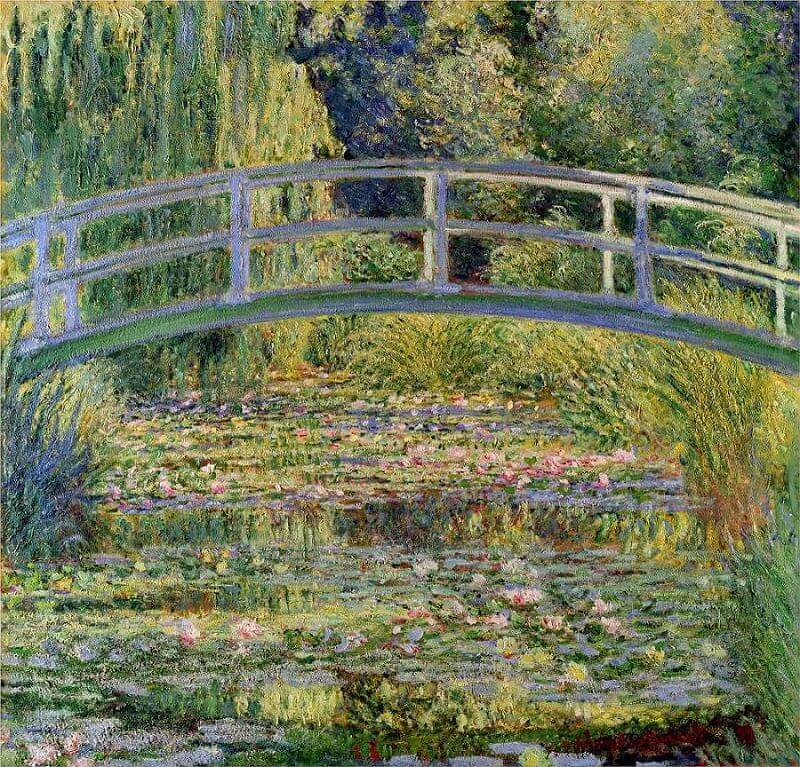
The Water Lily Pond, 1899
In 1883 when Monet moved to Giverny where he lived until his death, there, on the grounds of his property, he created a water garden ‘for the purpose of cultivating aquatic plants’, over which he built an arched bridge in the Japanese style.
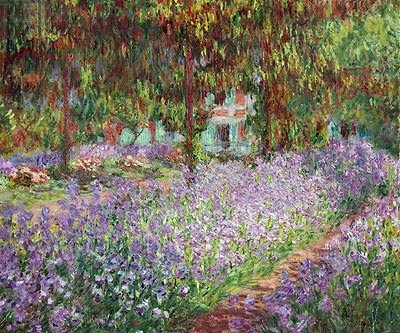
Irises In Monets Garden, 1900
The gardens of his homes were always guaranteed to be blooming with lilies and clusters of various flowers. Living most of his life in Northern France, Monet became an obsessive gardener and an obsessive painter of gardens.
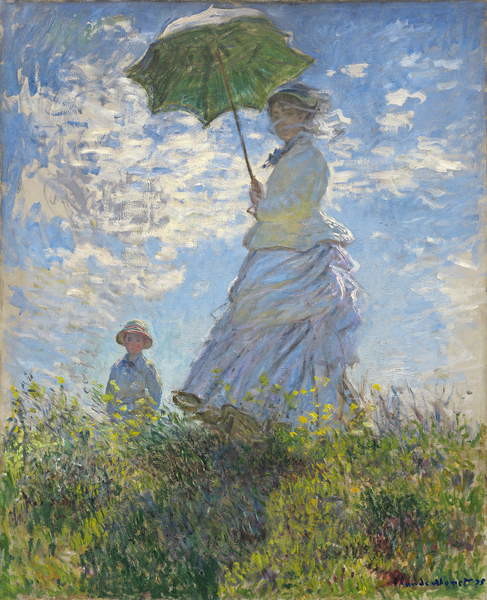
Woman with a Parasol – Madame Monet and Her Son, 1875
Woman with a Parasol was painted outdoors, probably in a single session of several hours’ duration. The artist intention was to convey the feeling of a casual family outing rather than a formal portrait, and used pose and placement to suggest that his wife and son interrupted their stroll while he captured their likenesses.
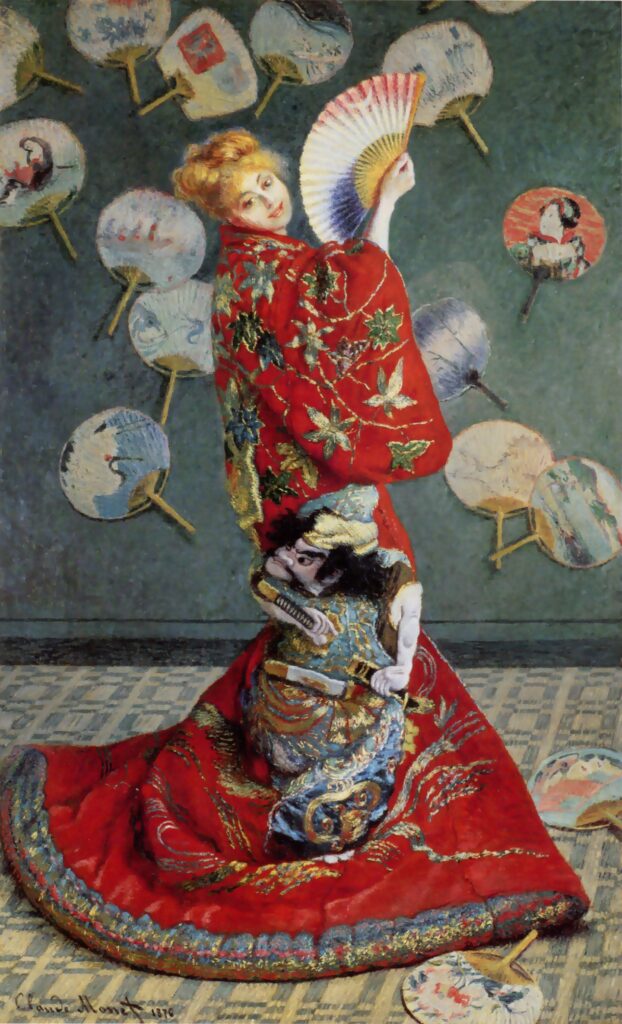
La Japonaise, 1876
La Japonaise was the last, a picture of his first wife, Camille, in Japanese costume. La Japonaise which means “the Japanese woman”, was not Monet’s original title for the painting. He actually showed it in 1876 as Japonerie, describing Western works that imitated Japanese objects. Monet went out of his way to present his naturally dark-haired wife as a blonde parisienne, at once disguising her identity and emphasizing her difference from the exotic objects that surround her: an elaborately embroidered kimono, a flock of sixteen paper fans, and what appears to be a tatami mat underfoot.
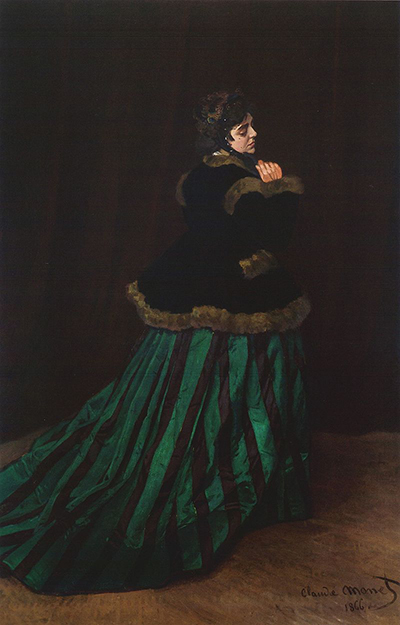
The Woman in the Green Dress, 1866
The subject of the painting was his favourite model and mistress, Camille Doncieux. She later became his first wife and the mother of his two sons. The aim was to enter this picture in ‘The Saloon’.
In the painting Camille is wearing a green and black striped dress with a train as well a fur-trimmed jacket. The hat is an Empire bonnet.
Photos Courtesy of Claude Monet.org

